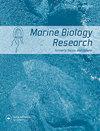Aglou Sidi Ifni海岸线(摩洛哥大西洋海岸)浮游植物的时空变化
IF 1.2
4区 生物学
Q4 ECOLOGY
引用次数: 0
摘要
摘要本研究于2014年4月至2016年3月进行。我们统计了以硅藻(126种)和甲藻(97种)为主的233种。最常见的硅藻物种是丹麦细圆藻和柄状根菌,而斯克里普菌是最常见的甲藻物种。硅藻的丰富度和相对丰度在2014-2015年春季和2015年冬季更高,并呈现出越来越大的南北梯度。然而,甲藻的数量在2014-2015年的夏季和秋季以及2016年的冬季更大,南北梯度呈下降趋势。这可能主要与这两个群体的需求之间的差异以及由洋流的季节和年际变化、洪水和该地区海岸形态所控制的水域物理化学特征的时空变化有关。事实上,甲藻丰富度和丰度的增加与环境中温度、透明度的增加和营养盐浓度的降低相吻合。然而,与甲藻相比,营养成分的增加、温度和透明度的降低有利于硅藻。本文章由计算机程序翻译,如有差异,请以英文原文为准。
Spatiotemporal variability of phytoplankton in the Aglou-Sidi Ifni coastline (Moroccan Atlantic Coast)
ABSTRACT This study was carried out between April 2014 and March 2016. We counted 233 species dominated by diatoms (126 species) and dinoflagellates (97 species). The most common diatom species were Leptocylindrus danicus and Rhizosolenia styliformus, while Scrippsiella sp. was the most common dinoflagellate species. The richness and relative abundance of diatoms were greater during the spring of 2014–2015 and the winter of 2015 and present an increasing north–south gradient. However, those of dinoflagellates were greater during the summer and autumn seasons of the years 2014–2015 and the winter of 2016, with a decreasing north–south gradient. This could be mainly related to the difference between the requirements of these two groups and the spatiotemporal variability of the physicochemical characteristics of the waters governed by seasonal and inter-annual variations of the currents, by the floods and by the morphology of the coast in this area. Indeed, the increase in the richness and abundance of dinoflagellates coincides with the increase in temperature, transparency and the decrease in the concentration of nutrient salts in the environment. However, the increase in nutrient content, the decrease in temperature and transparency favours diatoms compared with dinoflagellates.
求助全文
通过发布文献求助,成功后即可免费获取论文全文。
去求助
来源期刊

Marine Biology Research
生物-海洋与淡水生物学
CiteScore
2.10
自引率
0.00%
发文量
55
审稿时长
6-12 weeks
期刊介绍:
Marine Biology Research (MBRJ) provides a worldwide forum for key information, ideas and discussion on all areas of marine biology and biological oceanography. Founded in 2005 as a merger of two Scandinavian journals, Sarsia and Ophelia, MBRJ is based today at the Institute of Marine Research, Bergen, Norway. The Journal’s scope encompasses basic and applied research from all oceans and marine habitats and on all marine organisms, the main criterium for acceptance being quality.
 求助内容:
求助内容: 应助结果提醒方式:
应助结果提醒方式:


